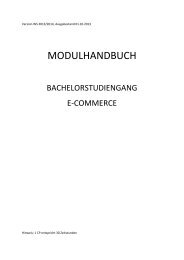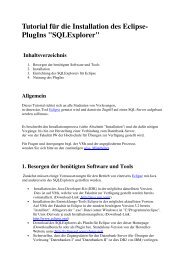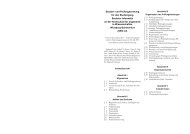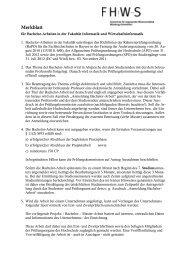FHWS Science Journal - Fakultät Informatik und Wirtschaftsinformatik
FHWS Science Journal - Fakultät Informatik und Wirtschaftsinformatik
FHWS Science Journal - Fakultät Informatik und Wirtschaftsinformatik
Create successful ePaper yourself
Turn your PDF publications into a flip-book with our unique Google optimized e-Paper software.
Eberhard Grötsch, Alfredo Pina, Michael Schneider, Benno Willoweit<br />
Basically, there are two approaches towards linguistic analyzing:<br />
The „formal“ approach:<br />
Every sentence represents a logical statement („Proposition“), and we have to translate every<br />
sentence into meta-language. Those languages are called „Meaning Representation Languages“<br />
(MRL) and are often based on first order logic or the lambda calculus.<br />
The „cognitive“ approach:<br />
One can‘t determine the exact meaning of a sentence by the sentence itself. A straightforward<br />
translation of language into a logical representation is therefore impossible.<br />
In the process of <strong>und</strong>erstanding there is a lot of backgro<strong>und</strong> knowledge involved.<br />
This knowledge may be specific to a single person or a group of persons (e.g. cultural or<br />
personal backgro<strong>und</strong>)<br />
4.4.1 Adoption in Computational Linguistics<br />
The formal approach is well explored and adopted in Computational Linguistics.<br />
Its main advantages are easy integration with code and other logical structures like semantic<br />
networks. The disadvantage is that it is not language agnostic and very narrow in scope (one has<br />
to define logical expressions for every meaning of a sentence).<br />
The cognitive approach was investigated mainly by adopting Fillmore‘s work on frame<br />
semantics, which he developed back in the 1970s (Fillmore, 2006). His idea was that the meaning<br />
of a sentence can be described by a so-called frame or a combination of those. A frame is<br />
consisting of:<br />
• A description which outlines the meaning of the frame<br />
• A number of frame elements (FE) that describe possible roles or agents<br />
• Relations to other frames, including specialization, part-of or temporal relations<br />
• A number of language specific lexical units, i.e. words or groups of words, which may<br />
evoke that frame.<br />
The main advantage of the cognitive, frame-based approach is, that frames are language<br />
agnostic, so only the lexical units that may evoke a frame have to be defined per language. Every<br />
frame is a formal representation of meaning, so there is no reason to build an own metalanguage.<br />
The scope is very broad and not limited to a specific application.<br />
4.4.2 Software Tools for FrameNet Based Analysis (Cognitive Approach)<br />
The FrameNet database consists of a large set of XML files (FrameNet, 2012).<br />
Frame semantic parsers relying on FrameNet already exist, both systems use a probabilistic<br />
approach:<br />
• SHALMANESER (English, German) is a project at Saarland University, Saarbrücken,<br />
Germany<br />
10 <strong>FHWS</strong> <strong>Science</strong> <strong>Journal</strong>, Vol. 1, No. 1, 2013








